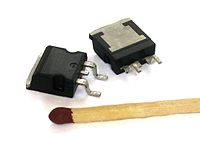
Photo from wikipedia
Tantalum and its alloys are regarded as equipment construction materials for processing aggressive acidic media due to their excellent properties. In this study, the influence of severe rolling (90%) on… Click to show full abstract
Tantalum and its alloys are regarded as equipment construction materials for processing aggressive acidic media due to their excellent properties. In this study, the influence of severe rolling (90%) on the dissolution rate of a cold-rolled Ta-4%W sheet in different directions was investigated during immersion testing and the corresponding mechanism was discussed. The results show that the dissolution rate of the cold-rolled sample is significantly lower than that of the undeformed sample. The corrosion resistance followed the sequence of “initial” < “90%-ND” < “90%-RD” < “90%-TD”, while the strength is in positive correlation with the corrosion resistance. Severe rolling promotes grain subdivision accompanied by long geometrically necessary boundaries and short incidental dislocation boundaries on two scales in the cold-rolled sample. The volume elements enclosed by geometrically necessary boundaries form preferential crystallographic orientations. Such preferential crystallographic orientations can greatly weaken the electrochemical process caused by adjacent volume elements, resulting in greatly reduced corrosion rates in the severely deformed sample. The unexpected finding provides a new idea for tailoring the structures of tantalum alloys to improve both their strength and corrosion resistance.
Journal Title: Materials
Year Published: 2022
Link to full text (if available)
Share on Social Media: Sign Up to like & get
recommendations!